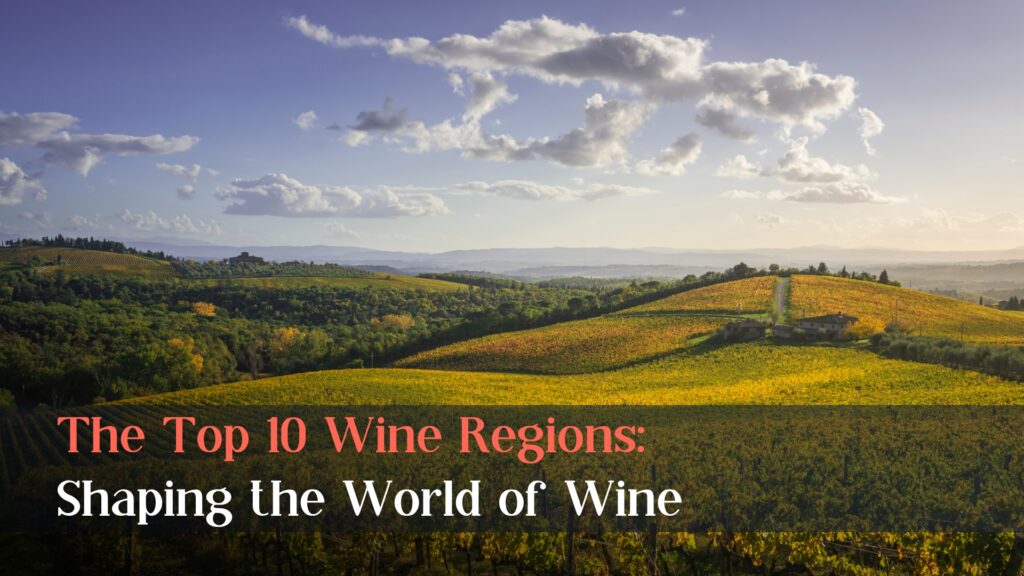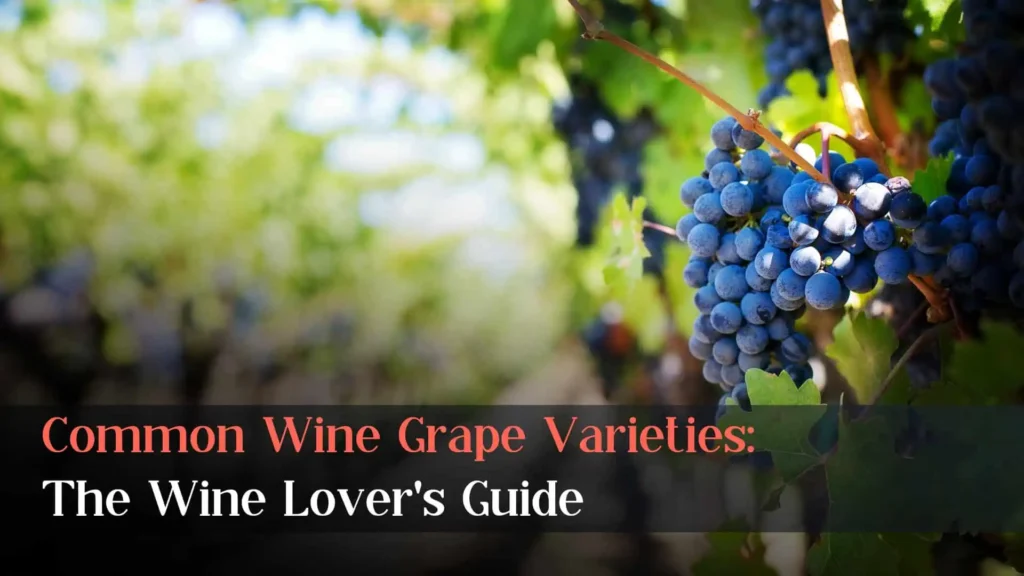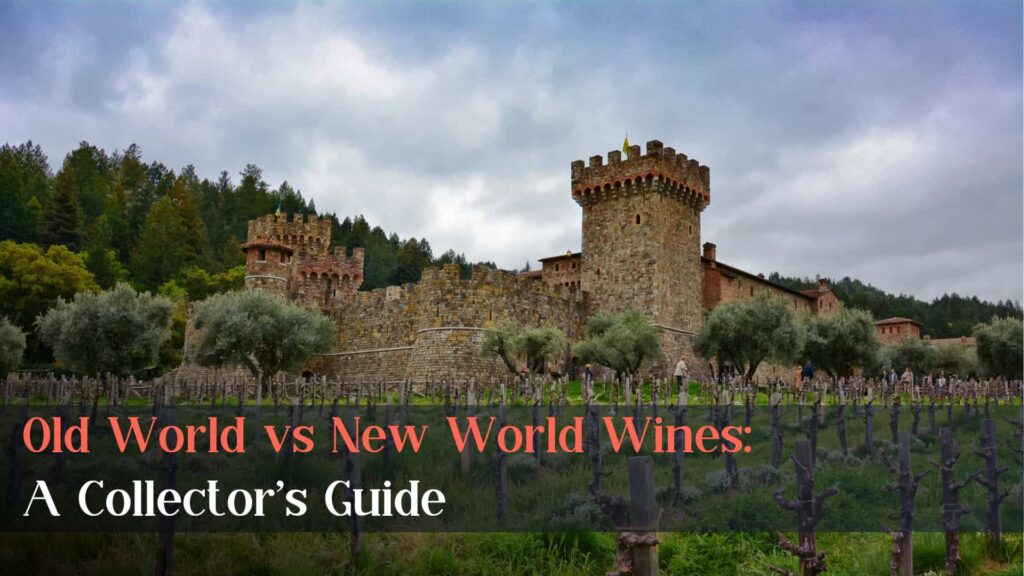The world of fine wine is vast and diverse, with each bottle telling a unique story of its origin, craftsmanship, and the terroir from which it was born. For wine enthusiasts and collectors, understanding the world’s top wine regions is essential for appreciating the full spectrum of flavors, styles, and histories these regions offer. Whether you’re a seasoned connoisseur or just beginning your wine discovery journey, exploring these renowned regions is a gateway to experiencing some of the finest wines ever produced.
In this article, we’ll take you on a journey through the top 10 wine regions of the world, each celebrated for its unique contribution to the global wine landscape. We’ll delve into the key grapes, terroirs, notable wineries, and what makes each region stand out. Whether you’re looking to expand your collection or simply broaden your wine knowledge, this guide will provide insights into the most iconic and influential wine regions that every wine lover should know.
Table of Contents
ToggleTop 10 Wine Regions of the World
Bordeaux, France
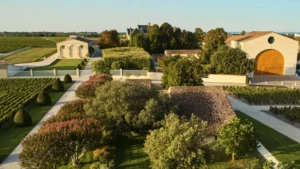
Bordeaux, located in southwestern France, is synonymous with elegance and tradition in winemaking. The region is divided into the Left Bank and Right Bank, each known for producing distinct wine styles. With its gravelly soils, the Left Bank favors Cabernet Sauvignon, resulting in structured and age-worthy wines. The Right Bank, with more clay-rich soils, is known for softer, Merlot-dominated blends.
Bordeaux is also the birthplace of the en primeur system, where wines are sold before they are bottled, allowing collectors to purchase highly sought-after wines at an early stage. Today, Bordeaux continues to set the standard for fine wine, influencing winemaking techniques and wine investment trends globally.
- Key Grapes: Cabernet Sauvignon, Merlot, Cabernet Franc, Petite Verdot
- Notable Sub-Regions: Médoc, Saint-Émilion, Pomerol
- Terroir: Maritime climate, gravelly and clay soils
- Notable Wineries: Château Margaux, Château Latour, Château Pétrus, Château Cheval Blanc
Tuscany, Italy
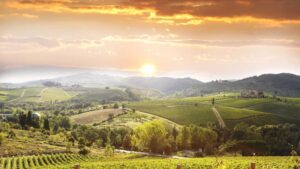
Tuscany is a quintessential Italian wine region, steeped in history and tradition. The region is characterized by its rolling hills, sun-drenched vineyards, and medieval towns. Tuscany’s wines, particularly Chianti and Brunello di Montalcino, are known for their bright acidity, firm tannins, and flavors of cherry, earth, and herbs.
Today, Tuscany continues to influence global wine trends with its emphasis on quality, tradition, and innovation, particularly in organic and biodynamic viticulture.
- Key Grapes: Sangiovese, Canaiolo, Trebbiano
- Notable Sub-Regions: Chianti Classico, Brunello di Montalcino, Bolgheri
- Terroir: Mediterranean climate, hilly terrain with clay and limestone soils
- Notable Wineries: Antinori, Castello di Ama, Biondi Santi, Tenuta San Guido
Champagne, France
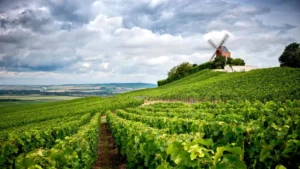
Champagne, the birthplace of sparkling wine, is located in northeastern France. The region’s chalky soils and cool climate are essential to producing Champagne’s signature crisp acidity and fine bubbles. The wines of Champagne are typically blends of Chardonnay, Pinot Noir, and Pinot Meunier, with each grape variety contributing unique characteristics.
Champagne continues to shape the world of wine by leading innovations in sparkling wine production and maintaining its status as a symbol of elegance and prestige.
- Key Grapes: Chardonnay, Pinot Noir, Pinot Meunier
- Notable Sub-Regions: Montagne de Reims, Côte des Blancs, Vallée de la Marne
- Terroir: Cool climate, chalky soils
- Notable Wineries: Bollinger, Veuve Clicquot, Dom Pérignon, Krug
Burgundy, France
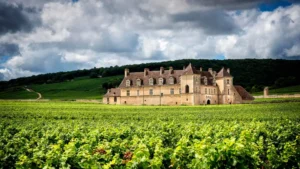
Burgundy, known for its terroir-driven wines, produces some of the world’s most sought-after Pinot Noir and Chardonnay. The region is divided into several sub-regions, each with its own unique expression of these grapes. Burgundy’s wines are prized for their elegance, complexity, and ability to age gracefully. The concept of “terroir” is central to Burgundy, where even small differences in soil and microclimate can lead to vastly different wines.
Burgundy continues to shape the global wine market with its emphasis on terroir-driven wines and its influence on the rise of single-vineyard bottlings worldwide.
- Key Grapes: Pinot Noir, Chardonnay
- Notable Sub-Regions: Côte de Nuits, Côte de Beaune, Chablis
- Terroir: Continental climate, limestone and marl soils, varied microclimates
- Notable Wineries: Domaine de la Romanée-Conti, Domaine Leflaive, Domaine Faiveley
Rioja, Spain

Rioja, one of Spain’s most prestigious wine regions, is renowned for its Tempranillo-based red wines, which often exhibit flavors of red fruit, leather, and vanilla. The region’s winemakers have mastered the art of aging wine in oak, resulting in complex and layered flavors. Rioja’s wines are classified based on aging duration, with Gran Reserva being the most aged and refined.
By blending tradition and innovation, with its aging classifications and modern winemaking techniques Rioja continues to influence the global appreciation of Tempranillo and barrel-aged wines.
- Key Grapes: Tempranillo, Graciano, Garnacha
- Notable Sub-Regions: Rioja Alta, Rioja Alavesa, Rioja Baja
- Terroir: Continental and Mediterranean climate, limestone and clay soils
- Notable Wineries: Marqués de Riscal, Bodegas Muga, La Rioja Alta, López de Heredia
Napa Valley, USA
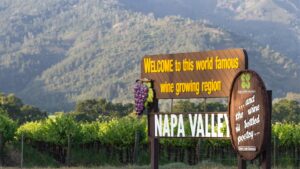
Napa Valley is the heart of the American wine industry, known for its bold and expressive wines. The region’s diverse microclimates, ranging from cool foggy areas to warm, sun-drenched valleys, allow for a wide variety of grapes to thrive. Napa’s wines, especially its Cabernet Sauvignon, are celebrated for their intensity and complexity.
Napa Valley has been instrumental in establishing American wines on the world stage, particularly through its pioneering role in sustainable winemaking practices.
- Key Grapes: Cabernet Sauvignon, Chardonnay, Merlot
- Notable Sub-Regions: Stags Leap District, Rutherford, Oakville
- Terroir: Mediterranean climate, varied soils from volcanic to alluvial
- Notable Wineries: Opus One, Stag’s Leap Wine Cellars, Robert Mondavi, Screaming Eagle
Mendoza, Argentina

Mendoza is Argentina’s largest and most important wine region, situated at the foothills of the Andes. The region’s high-altitude vineyards, combined with ample sunshine and low rainfall, produce grapes with concentrated flavors and balanced acidity. Mendoza’s Malbec has become world-famous for its deep color, velvety texture, and rich fruit flavors.
Mendoza is redefining New World winemaking by showcasing the potential of high-altitude viticulture and driving the global popularity of Malbec.
- Key Grapes: Malbec, Cabernet Sauvignon, Chardonnay
- Notable Sub-Regions: Luján de Cuyo, Uco Valley, Maipú
- Terroir: High-altitude vineyards, alluvial soils, arid climate
- Notable Wineries: Catena Zapata, Bodega Norton, Zuccardi, Achaval Ferrer
Barossa Valley, Australia

Barossa Valley is Australia’s premier wine region, known for its bold and powerful Shiraz. The region’s warm climate and fertile soils create ideal conditions for producing wines with intense fruit flavors and high alcohol content. Barossa Valley is also home to some of the world’s oldest Shiraz vines, dating back to the 19th century.
Barossa Valley continues to shape the global wine industry with its robust, full-bodied Shiraz, which has become synonymous with Australian red wine, setting a benchmark for powerful yet balanced wines.
- Key Grapes: Shiraz, Grenache, Mataro (Mourvèdre)
- Notable Sub-Regions: Eden Valley, Seppeltsfield, Marananga
- Terroir: Warm climate, rich red clay soils
- Notable Wineries: Penfolds, Henschke, Yalumba, Torbreck
Maipo Valley, Chile
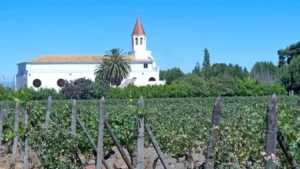
The Maipo Valley is often referred to as the “Bordeaux of South America,” renowned for producing some of Chile’s finest and most prestigious wines. Located just south of Santiago, the Maipo Valley is one of Chile’s oldest wine regions, with vineyards dating back to the 16th century. The region benefits from a Mediterranean climate with warm, dry summers and cool nights, which create ideal conditions for growing robust red varieties.
The valley is particularly celebrated for its Cabernet Sauvignon, which offers a distinctive profile of ripe black fruit, spice, and elegant tannins. The Maipo Valley has helped to establish Chile as a leader in sustainable viticulture and premium red wine production.
- Key Grapes: Cabernet Sauvignon, Carmenère, Syrah, Merlot
- Notable Sub-Regions: Alto Maipo, Central Maipo, Pacific Maipo (Maipo Bajo)
- Terroir: Mediterranean climate, alluvial and gravelly soils
- Notable Wineries: Concha y Toro, Viña Santa Rita, Viña Cousiño Macul, Almaviva
Marlborough, New Zealand
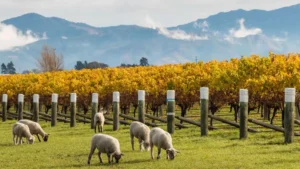
Marlborough, located at the northeastern tip of New Zealand’s South Island, is the country’s most celebrated wine region, particularly known for its exceptional Sauvignon Blanc. The region gained international acclaim in the 1980s when its Sauvignon Blanc burst onto the global stage, renowned for its vibrant, zesty flavors and intense aromatics. Marlborough’s unique terroir, with its cool climate, abundant sunshine, and well-drained soils, creates ideal conditions for producing wines with bright acidity and pronounced fruit characteristics.
While Sauvignon Blanc is the star, Marlborough also produces high-quality Pinot Noir, Chardonnay, and Riesling. Marlborough continues to influence global wine trends with its innovative approach to Sauvignon Blanc, setting a benchmark for New World white wines.
- Key Grapes: Sauvignon Blanc, Pinot Noir, Chardonnay, Riesling
- Notable Sub-Regions: Wairau Valley, Southern Valleys, Awatere Valley, Dashwood
- Terroir: Cool climate, stony and alluvial soils
- Notable Wineries: Cloudy Bay, Villa Maria, Brancott Estate, Dog Point Vineyard
Wrap-Up – Wine Regions of the World
These top wine regions represent the pinnacle of winemaking, each offering something distinct in terms of flavor, style, and heritage. Understanding the characteristics of these regions can enhance your appreciation for the wines they produce, whether you’re collecting, trading, or enjoying a bottle.
While other regions worldwide also produce fantastic wines, these 10 are a great starting point if you’re just starting to learn about the world of wine! Explore the GrtWines’ marketplace to experience some of these wine regions yourself!
